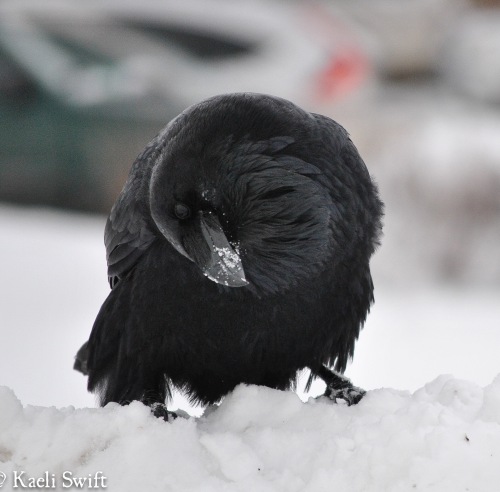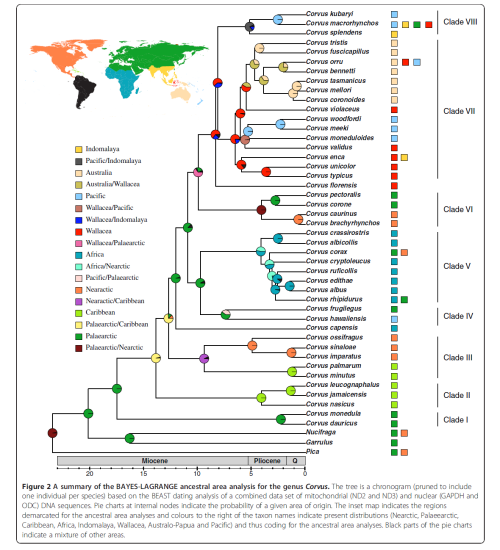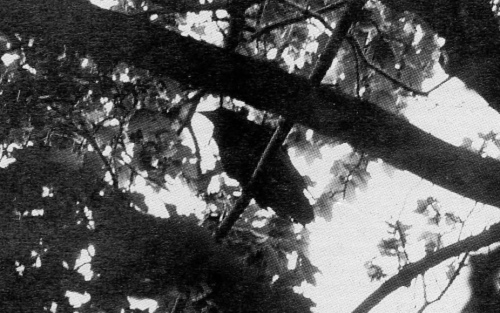This feels like a simple enough question but answering it requires a check on how scientists define ‘species,’ a look at the phylogeny of crows and ravens (that’s the study of the evolutionary development and diversification of species i.e. the study of the tree of life), as well as an understanding of how their biology determines whether “Can they hybridize?” turns into “Do they hybridize?”

A rather curious question indeed.
For decades, the textbook standard for defining the term ‘species’ in introductory biology classes has been the biological species concept. First coined in 1942 by ornithologist Ernst Mayr, this is the idea that a species is a population of animals that share a gene pool, and can successfully mate with each other, but not with animals outside their gene pool. Almost always, the pudding offered as proof is a mule; the sterile offspring of a breeding attempt between a horse and an ass. “See,” your teacher would say, “The offspring are sterile because it’s the result of two different species,” and then they would slap their hands together like a satisfied chef. But of course, nature is rarely so inclined to follow such rules.
In fact, lots of animals we consider distinct species can and do interbreed. Possibly even more problematic is that there are plenty of living things that don’t reproduce sexually at all. So how do you define them under this concept? These issues have left scientists jaded and unsatisfied with the biological species concept and given rise to new classification schemes that don’t consider sex. One of the most robust rivals to the biological concept is the phylogenetic species concept, where species are defined by their evolutionary histories. The problem with this concept though is that sometimes the amount of hair splitting that goes on divides formally unified species beyond what is perhaps biologically appropriate. Meaning, if two species have a distinct evolutionary history, but fulfill the same ecological role, look the same, and freely interbreed, are they really distinct species? Without going too far further down this rabbit hole suffice it to say that there still remains no universally accepted scientific definition of a species, and that more than likely the most comprehensive approach is one that takes into consideration an each organism’s unique situation and leans on multiple concepts as appropriate.
This is relevant to American crows and common ravens because knowing that they are two different species might incline some people to believe that the answer to the question “Can they interbreed?” is, by definition, “No.” However, hopefully now it’s clear that such dogmatism will only hamper our understanding of the situation. To advance further on this question, we instead need turn our attention to the tree of life.
For animals to freely interbreed, they generally need to share a very recent relative. Given their geographical overlap and how similar American crows and common ravens look, it might be tempting to assume they must be quite closely related, but of course by now you know what assuming will get you. As you can see from the phylogentic tree below, you need to go back four ancestors (or about 7 million years) to find the relative shared by both birds.1 American crows are actually more closely related to the collared crows of China than they are to common ravens. So, while we haven’t ruled on our original question one way or another just yet, this suggests it shouldn’t happen extremely freely.

Jønsson et al. 2012
For the last piece we need to consider the real life, biological relationship between these birds. Most crucially, we need to ask if, when in close proximity, they generally tolerate each other and socialize.
A paper out earlier this year by Freeman and Miller answers this question with a resounding, “No.”2 Thanks to thousands of observations provided by citizen scientists, the authors were able to show that most interactions between the two are aggressive, and that crows are almost always the aggressor, particularly during the reproductive period. This is thanks in no small part to the fact that ravens will depredate crow nests. Therefore, come breeding time, crows will be most anxious to evict ravens, not bed them.

A crow attempts to chase a raven out of its territory
With all this in mind, it seems we can finally conclude that the most informed answer would be, “Ravens and crows do not hybridize…
…most of the time.”
Ok time for me to come clean. The truth is that I’ve buried the lead a little bit here, because in fact we know the answer to the question “can they hybridize.” In the 1990’s Beth Jefferson documented a successful breeding attempt between a wild American crow and common raven in Toronto, Canada.3 In 1990, the single raven started showing up in the area; a surprise to the local birders since they didn’t usually encounter ravens for another 145km north. Over the course of the next three years, the raven appeared to be buddying up to a crow in the area. It wasn’t until 1993, however, that Beth and other locals were able to document the pair nest building, attending to nestlings, and successfully fledgling two young.

One of the hybrid young documented by Beth Jefferson
So why on earth did I drag this out so much? Because your take home message should not be that crows and ravens are going buck wild making little cravens. Just as one swallow does not a summer make, one or two craven babies does not a habit make. By and large, American crows and common ravens are reproductively isolated and do not hybridize. But under the strangest of circumstances there’s no questioning that…

Literature cited
- Jønsson K.A., Fabre P.H., and Irestedt, M. 2012. Brains, tools innovations and biogeography in crows and ravens. BCM Evolutionary Biology 12
https://bmcevolbiol.biomedcentral.com/articles/10.1186/1471-2148-12-72 - Freeman B.G. and Miller, E.T. 2018. Why do crows attack ravens? The roles of predation threat, resource competition, and social behavior. The Auk 135: 857-867
http://www.bioone.org/doi/full/10.1642/AUK-18-36.1 - Jefferson E.A. 1994. Successful hybridization of common raven and American crow. Ontario Birds. https://sora.unm.edu/sites/default/files/27-35%20notes%20OB%20Vol12%231%20Apr1994.pdf

Nature hates categories
Really interesting read, and good ending point. I had wondered if this had ever happened after finding a couple of birds in my area that made me wonder if they might be “Cravens.” More than likely they were not, and I also wondered if they may be misplaced Chihuahuan Ravens, but the odd calls they made seemed split right between crow and raven.
The definition of species is one of my favorite topics, and you just gave me a new favorite example to keep in my pocket for the complexity of the when/whether species hybridize.
An excellent summary of of the species question in general, thanks for this!
What an interesting read, I have a captive bred raven and a wee rescue hoodie crow, raven is DNA sexed female but who knows with the hoodie. They seem to get on well enough, thank goodness wee “Elsie” is very, very wee and “Eva is …..well,big.
I have seen a bird in the local supermarket car park sitting on a handrail, It seemed too big to be a crow and yet does not have the ragged gullet of a raven His beak was about 100mm long and curved and about 25mm deep at the nose. Could he have been a craven
Unlikely. If you snap a photo you are welcome to share it with me for an ID.
For the last three years, I have watched a guy I am certain is some sort of hybrid,
1. He wonks like a Raven.
2. He has a Raven’s beak,
3. He’s twice the size of the crows he hangs with.
4. He has a CROW’s fan tail. Impressive fan. Gorgeous.
5. He is also quite gregarious, (something I haven’t personally witnessed with Ravens).
6. He hangs with the Crows, and not the Ravens. And the crows interact with him.
I feed the local crows unsalted peanuts, and we all coo back and forth. He makes a long sort of chuffing sound at me, but does not coo like the crows.
Hi Jacqui, you are welcome to send a photo and get another opinion. kaelis@uw.edu
I absolutely love this article, and especially how you ended it (my all time favourite movie line). I found this after searching the subject upon hearing what sounded like a crow but a bit like a raven. In 2006 when we moved to this house, we had a family of crows. However, what appeared to be the ‘papa’ crow was, to my assumption, possibly a raven or a mix of the two. A massive bird compared to his family. This was before I really got involved in knowing the difference but I stand by my assumption. The family stayed for quite a few years, even through the prairie winters, and eventually flew off one winter and papa did not return in the spring with the rest of the family. Perhaps they flew him somewhere warmer for his last season.
I know that cravens are being captive bred (I know of one Santa Cruz county falconer who has one), but there appears to be a wild pair in my own neighborhood. Quite large for crows, and with a rounded tail edge in flight, but caw like crows and with much smaller beaks than is typical for ravens and none of the shaggy throat/beak feathering seen in ravens.
They are ruling the roost, so to speak, this spring in my suburban/urban Oakland neighborhood. I don’t have a long lens camera, so unsure how I could get you a good photo. Can cravens share characteristics with both species? That appears to be the case here. Or do crows sometimes have rounded rather than straight tail edges?
Please advise!
Hi Debbie, crows can have very round looking tails when fully fanned, so the wedge shape is a better field mark here. I am currently working on a post on distinguishing crows and ravens that will have lots of reference images for tail shape. Hopefully that will help!
Thanks! The more that I observe these big crows, the more that I believe that is all that they are.
We have a very large “raven” who does both calls, crow and raven and sometimes does both in a single series of calls. The “raven” is usually alone until feeding time, then all 5 eat together. The “raven” has left me trinkets on the spot where we feed them. First it was a dime and later it was an iridescent flat marble. The “raven” is my buddy, follows me around and perches very close in sight just to get my attention and be fed. It is a very strange group. They work together against the local hawk but seem distant until feeding time. I love watching these birds and their relationships. The “raven” is the most social, is much larger, no shaggy throat but does have a much larger beak than the other “crows”. How long do these birds live? This particular “raven” has been here for years now. Even the UPS driver looks for him on the phone pole when he sees me putting meat out or peanuts. This bird sits just 2-3 feet away from me and does not retreat like the other “crows” do when I fill the bird bath, bring food and stand there talking to him. Quite an experience!!
Hi Donna, crows and ravens can live around 17 years. If you want to email me a photo I’d be happy to help you ID your mystery bird! kaelis@uw.edu
Pingback: The definitive guide for distinguishing American crows & common ravens |
Great article, I would really like to know the name of the bird that both ravens and crows ?
Thank you!
Hi Amanda, they don’t have an official name because it’s not a recognized species/animal. So you could get creative!
Thank you
Good idea!
Are there any indications of what this bird might look like? I’d like to see an artist impression of these types of birds or have an idea of size from a skeleton. Where would I find out?
If I’m reading the data right are magpies pretty much unchanged?
Not really any good resources on that because hybridization in the wild is so exceedingly rare. But I’ve heard rumors that people in the illegal pet industry are messing with this.
Since the study only looked at Corvus species, the phylogenetic tree includes the Pica, Nucifraga and Garrulus genera so you could see the evolutionary relationship between the 4 genera. It doesn’t tell you anything about the evolutionary histories within those 3 non-Corvus genera though. Does that make sense?
Not really…. But it’s not you it’s me! I want a really simple solution that I assume must not be possible. To see an illustration of the equivalent of a woolly mammoth / sabre toothed tiger in corvid form (my imagination is conjuring up a tusked magpie……) and go ooh I can see how that became a magpie/crow etc.
Every day a school day for me, thank you!
After observing crows yesterday then seeing a video the guy who rescued a raven.. I began to wonder if they were basically the same bird with different names.. now that I read your article I recall observing a parrot that hung around with pigeons in Cincinnati about 20 years ago. I suppose it was lonely.
Great article!
Is it known whether Cravens would be sterile then?
Unknown to me, Risa!
Awesome information here and in all your articles!! I came across this page right at the top of my Google search (just as I so often come across your excellent articles while looking up anything corvid-related!) after trying to retrieve an article I recall reading years ago about crows and ravens both having been observed mating not infrequently with jackdaws if not with each other … Anyway, thank you for this endlessly rewarding blog!
I’ve been having fun watching one raven interacting with the local ‘teenaged’ mob of crows I have been feeding for awhile now. They are getting along startlingly well and I hope I keep wondering if the raven (age/gender unknown to me) has decided s/he prefers just hanging with this lively bunch rather than his/her own. 😉
One thing I find interesting is in my neighborhood, crows and ravens live in very close proximity to each other. The ravens roost about a 5 minute walk from my front yard. My front yard is presently home to 3 very active 1 year old crows. Ravens come and hang out in the trees, the crows tolerate their presence and will share bread when I toss it out to them.
Thanks so much for the very informative study I have been watching crows here in SoCal 5 yrs I feed them 2xs a day one day I found a dead one nxt day several flew soaring closely to someone’s head cawing unbelievable I feel he killed that baby
I came to this site because I have been hearing something that sounds halfway between a British crow and a raven. In fact it sounds like the American crows I hear in films.
Hi Trevor, it’s much more likely that it’s simple a unique carrion crow or raven, rather than a hybrid. Every individual’s voice is different and some have rather funny sounding calls.
I have a 4 bird, family of crows that have a, 4 bird family of ravens, as ” cousins”??
They are not aggressive with each other & all eat seeds, egg yolks & bread, out of my backyard. The ravens appear to be protecting the crows from the neighborhood hawk…who has decided it best to leave them all alone.
Interesting!
I’ve had this question in the back of my head for years now because the crows here in Colorado seem *huge* & their caws are often deeper than I expect. But I figured the answer was ‘unlikely’ (turns out I was basically right. Yay!).
I was halfway thru your article when I realized I knew you from twitter & followed you many moons ago. The internet at it’s finest 😂.
Did these crow/raven hybrids flock with crows or ravens.? I would think they weren’t fertile like some mallard hybrids.
There haven’t been enough of these birds to really say one way or other, I’m afraid.
In my front yard, there’s a family of crows which produce 8 or 9 chicks every year. About a 10 minute walk from here, a raven colony produces chicks too. This past winter, a juvenile raven has been hanging with the crows. They get on well and play and forage together.
Wow, that’s an incredibly high brood size for a crow! Well above average.
It is above average. Nova Scotia, like the rest of North America, had a really hot summer. I was seeing fledgling crows until the middle of August. Very weird. That’s 2 months later than usual.